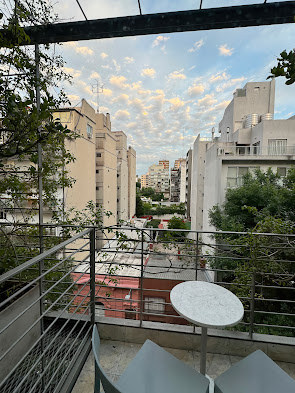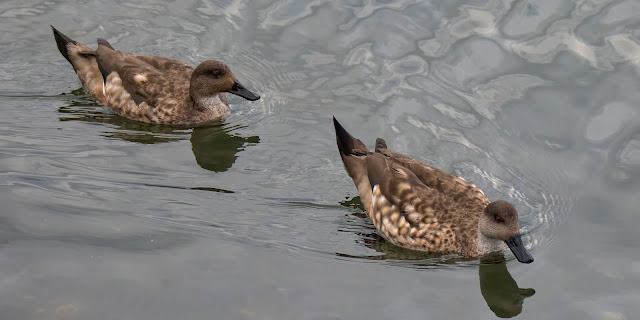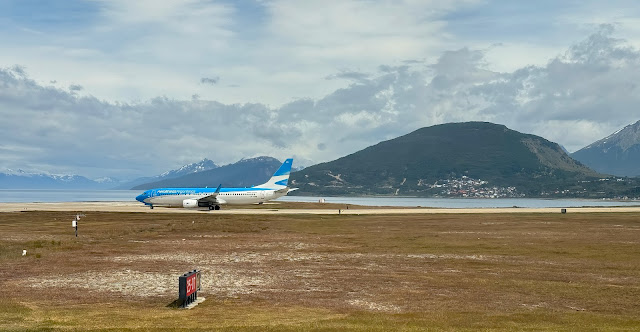 |
| A magical experience |
And, as my blogs will attest, Scott and I both love glaciers, icebergs, Whales and all the beauty associated with cold climates. That makes Antarctica a natural. The only things that had been holding us back is that it is a pricey destination and the Drake Passage is famous for rough (very rough) seas.
Still, every cool person we've met on our Arctic trips had been to Antarctica and loved it! Even with stories of rough (very rough) seas. We aren't getting any younger, so we decided to go.
Because it is pricey, we opted not to go on a luxury or lengthy trip, opting instead to go with a supplier that I had already used twice: G Adventures. My 2017 trip to Africa, which I loved, loved, loved, was with G Adventures.
And, Scott and I traveled with them in 2019 to my bucket-list destination of Svalbard. That trip exceeded my expectations.
We selected the Antarctic Classic trip, which departed from Ushuaia, Argentina, and spent nine days exploring the South Shetland Islands and Antarctic Peninsula. Well, actually three plus days getting there and back and six days exploring.
Not a great deal of Antarctica, but what looked like enough for a good taste.
Of course, now that we're back, I wish we had booked a longer trip and seen more. But, there was so much good about what we did that I can't help but think that doing a different trip might not have been so wonderful. So, we're happy.
When we booked, we were delighted to find that we were on the same ship we were on in Svalbard, the G Expedition. Cool!
 |
| The G Expedition |
Built in 1972 in Denmark as an ice-class car ferry, she operated in the Baltic Sea under several different names for several companies.
 |
| From the water |
G Adventures has sailed the G Expedition since 2009. The ship is rated at "Ice Class 1B," reflecting a thicker hull and more structural integrity than non-rated boats. Sea chests (openings in the hull for seawater intake) are arranged to ensure that they do not become blocked with ice and bulkheads have stronger waterproofing.
1B ships are not icebreakers, but they can travel in moderate ice conditions. We could travel among icebergs and brash associated with glaciers and could skirt the edge of the pack ice without having to worry about occasionally hitting some of the ice floes.
 |
| Our flag |
The G Expedition can hold up to 134 passengers; we had 127.
On Our Way
 |
| Our route |
We departed Dec. 30 and flew from Colorado Springs (much preferred to Denver, especially in winter!) to DFW.
Then, we headed on to Buenos Aires on American Airlines (using miles) on a 10-hour overnight flight that would put us in BA on New Year's Eve.
The next leg would be the next day on to Ushuaia, Argentina, which was the point of departure for the cruise.
From Colorado Springs to the Antarctic Peninsula is about 7,500 miles as the Crow (or, more accurately, Arctic Tern) flies.
The flight from DFW arrived at Ezeiza International Airport and the flight from BA south departed from Aeroparque Internacional Jorge Newbery, the smaller airport used for lots of domestic and intra-South-American flights The airports are 37 miles apart.
 |
| Aeroparque Internacional Jorge Newbery |
We booked our on AA flight and G Adventures booked the domestic flight on Aerolineaus Argentinas. The suggested a schedule straight-through with a two-hour connection. Obviously, that wouldn't work. So we opted to spend the night in BA and depart the next morning. That was a good call.
See Scott's video of us leaving Buenos Aires on New Year's Day.
When I originally booked our AA flight, we had a comfortable connection time in DFW. Then, AA changed one of the flights (SHOCKER!), creating what I felt was a too-short connection. So, I changed our COS flight, resulting in a seven-hour layover. It would be a looooong day, but I padded everything enough that we never had to fret about a missed connection or potentially missing something.
We actually left the airport in DFW and had lunch with our friend Bob before going back. Always nervous about things going wrong, I insisted we get back by 7:30 p.m. for our 10:30 flight. That would have been great except that the incoming flight was late and we left after midnight!!!! The loooong day got longer, but it also meant that our hotel room was ready when we finally got to Buenos Aires.
Since this was not a tour of Buenos Aires and we did not do anything there, I won't say too much about the city.
I was concerned that New Year's Eve would be raucous in Argentina, so I selected a nice little boutique hotel in a "quiet neighborhood." We checked in, showered and napped, venturing out around 7 p.m. for dinner.
 |
| Rooftop hot tub at the Palo Santo Hotel in Buenos Aires |
Much to our surprise, no restaurants were open! Nothing was happening. The neighborhood was beyond quiet; it was dead. When we asked about restaurants, we were told, "It's a holiday!" Hmmmm ...
Apparently not a holiday where people go out. Here's a video by Scott Stevens of us amid the frivolity.
So we ate leftover airline snacks and went to bed early.
 |
| From the hotel balcony |
What little we saw of Buenos Aires was a mix of urban nastiness and some beautiful, lush parks. But, I really can't say anything about the city.
On January 1, we flew from BA to Ushuaia, putting us in town a day before G Adventure's recommended arrival day. That meant we had the full day in Ushuaia to explore. G Adventures does offer land tours, but you can only book them onsite. That seems odd and I don't like to leave that kind of thing to chance. So, I opted to book a half-day private tour of Tierra del Fuego National Park in advance with Viator.
One interesting/funny thing about flying Aerolineas Argentinas: the baggage limits are more restrictive than the U.S., so we had one too many bags and one bag was too heavy. This was not a surprise because, with all our cameras, we usually have too much. I just didn't know what they would do about it.
So, you go to check in, standing in a long line. Then, you check your bags on and they tell you that you have too much and will have to pay. But you don't pay the check-in agent like you do in the US. Instead, they put stickers on your boarding pass and send you to cashier on the other side of the hall.
I stood in line (again) for what seemed like forever and then waited while lots of typing and printing and pulling forms went on. I had no idea what it was going to cost, so I was shocked when it was about $12.00 USD. All that for $12.00!! I almost laughed out loud. No wonder everyone had lots of bags!
Here is a video Scott shot of us flying in to Ushuaia.
Ushuaia
Located on the southern tip of South America, Ushuaia is the capital of Tierra del Fuego, Antártida e Islas del Atlántico Sur Province, Argentina.
 |
| 4,350-foot Mount Olivia dominates the skyline |
With a population of 82,615 and a location below the 54th parallel south latitude, Ushuaia claims the title of world's southernmost city. In fairness, there are settlements farther south, but the only one of any notable size is Puerto Williams, a Chilean settlement of some 2,000 residents.
 |
| Scenes from Ushuaia |
Bounded on the north by the Martial mountain range and on the south by the Beagle Channel (more about that later), it sits on a wide bay. The town's name, which comes from the indigenous Yaghan language, means "deep bay."
Ushuaia is the only city accessed from the rest of the country by crossing part of the Andes mountain range that runs along the southern edge of Tierra del Fuego.
 |
| Map: Wikipedia |
The section coming into Ushuaia requires drivers to go into Chile to take a ferry across the Straits of Magellan, a narrow channel in northern Tierra del Fuego, which puts them back in Argentina.
I know that road access to Ushuaia is fairly recent, but cannot find the actual year the road opened.
Ushuaia has been inhabited for about 10,000 years since the arrival of the Selk'nam people, also called the Ona. The southern group of these indigenous people are known as the Yaghan or Yámana.
They were traditionally nomads and hunter-gatherers who traveled by canoe between islands to collect food. The men hunted sea lions and the women dove to collect shellfish.
 |
| Yaghan People; Art: Sapiens.org |
Our guide told us that they often wore no clothes, which is surprising in Ushuaia's chilly climate. They covered themselves in animal grease to trap heat and provide an extra layer of fat. Over time, they evolved significantly higher metabolisms than average humans, allowing them to generate more internal body heat. When they wore clothes, it was made from South American Sea Lion pelts.
The town was founded informally by British missionaries, following previous British surveys, long before Argentine nationals or government representatives arrived there on a permanent basis.
The British ship HMS Beagle, under the command of Captain Robert FitzRoy, first reached the channel on January 29, 1833, during its maiden voyage surveying Tierra del Fuego.
 |
| HMS Beagle; Art: Wikipedia |
Missionary Thomas Bridges learned the Yaghan language, became a fluent speaker, created a phonetic alphabet and wrote a dictionary for the spoken-only Yaghan language.
In 1873, the first Argentine citizens to visit Ushuaia arrived to teach school. About a decade later, plans were launched to create a penal colony modeled after one in Tasmania, Australia, in an effort to secure permanent residents from Argentina and to help establish Argentine sovereignty over all of Tierra del Fuego.
During the 1880s, prospectors came to the area following rumors of large gold fields, which proved to be false. In 1884, the town was formally established. The first census in 1893 recorded 113 men and 36 women.
Ushuaia suffered several epidemics, including typhus, pertussis and measles, that reduced the native population. But, because the Yaghan were not included in census data, the exact death toll is not known. In addition, many were killed by European settlers and as a result of deliberate poisoning to exploit the Sea Lions, the staple of their diet. By 1911, almost all of the Yaghan had disappeared, so the mission was closed. The population dropped from 3,000 people in 1880 to less than 100 by the 1990s.
In 1896, the prison received its first inmates, mainly re-offenders and dangerous prisoners transferred from Buenos Aires, but also some political prisoners.
The prison population became forced colonists and spent much of their time building the town with timber from the forest around the prison. They also built a railway to the settlement, now a tourist attraction known as the End of the World Train (Tren del Fin del Mundo), the southernmost railway in the world.
 |
| The Train at the End of the World; Photo: Rail South America |
The steam-engine-driven railway connected the prison camp with the forestry camp, serving as a freight line to transport prisoners to the camps and to carry logged timber from forests. The railway was closed in 1952, following the reduction in forest resources and an earthquake that damaged the tracks, but three miles of the route were reopened in 1994 as a tourist attraction.
The prison operated until 1947, when it was closed in response to reports of abuse and unsafe practices. Most of the guards stayed in Ushuaia and prisoners were relocated to other jails further north. After the prison closed, it became a part of the Base Naval Ushuaia, functioning as a storage and office facility until the early 1990s. Later it was converted into the current Museo Maritimo de Ushuaia.
 |
| A local tour goes to the Museums; Photo: Scott Stevens |
The naval base at Ushuaia was active during the Falklands War of 1982. The Argentine cruiser ARA General Belgrano, subsequently sunk by the British Fleet, sailed from the Port of Ushuaia, where a memorial was erected in 1996.
 |
| The Naval Base is right in town on the harbor |
Now, Ushuaia is a light industrial port and hub for tourists traveling to Antarctica, which is only 680 miles away.
It has an ocean-moderated mild climate with cool conditions throughout the year. Temperatures generally remain above 32°F and below 50°F year-round. While we were there, we had a combination of overcast and sun and generally didn't even need a jacket. Everyone told us that it was their first warm weather of the summer.
Due to its extreme southern latitude, the duration of daylight varies significantly, from more than 17 hours in summer to just over seven hours in winter.
Ushuaia is the key access point to the Southern Ocean, including subantarctic islands of South Georgia and the South Sandwich Islands and Antarctic islands including the South Orkney Islands and the South Shetland Islands. Its commercial pier is the major port of departure in the world for tourist and scientific expeditions to the Antarctic Peninsula.
Cruise ships visiting the Falkland Islands and Antarctica dock at the port, as well as ships that transit from Valparaíso, Chile, to Buenos Aires and beyond. Passenger and freight lines provide regularly scheduled services between Ushuaia and local seaports and settlements.
 |
| A busy day on the dock; Photo: Scott Stevens |
We spent a fair amount of time just wandering around town and walking along the harbor, which was right across the street from our hotel, the Albatross.
Unlike a lot of South America, Ushuaia seemed very safe. I was never uncomfortable walking around, even by myself.
 |
| A comfortable town |
When we first checked into the hotel, I heard birds singing loudly right outside my room.
 |
| Really???? |
So, I grabbed my camera and ran outside for my first Argentina bird sighting. I was expecting something exotic.
It was a ...
... House Sparrow!
Really???? Really????
I swear House Sparrows live in every city in the world.
I had better luck along the harbor, seeing ...
 |
| Dolphin Gulls, adult and immature |
 |
Kelp Gulls, adult and ... |
 |
| ... Immature |
 |
| Crested Ducks |
And, Scott found me some colorful Southern Lapwings right on the harbor.
 |
| Gorgeous birds (and loud!) |
Ushuaia is known for its king crab, although finding some in restaurants proved a bit harder than we expected.
 |
| When we had some, it was OK, but not as sweet as I am used to |
The town isn't large and we probably squandered our time. We didn't visit the Prison Museum and we didn't find any interesting local crafts.
 |
| I even did it messy like a real immigration officer |
In Ushuaia, the Visitor Information Station has a passport stamp station. Allegedly, it is for actual (not National Park) passports. I stamped mine. I hope it's OK. I mean, the line was very long and everyone else was doing it!
G Adventures checked our passports before we departed, but, as one would expect, Antarctica has no immigration centers.
That's it for our short time in Ushuaia. In my next post, I'll talk about Tierra del Fuego National Park ...


















No comments:
Post a Comment